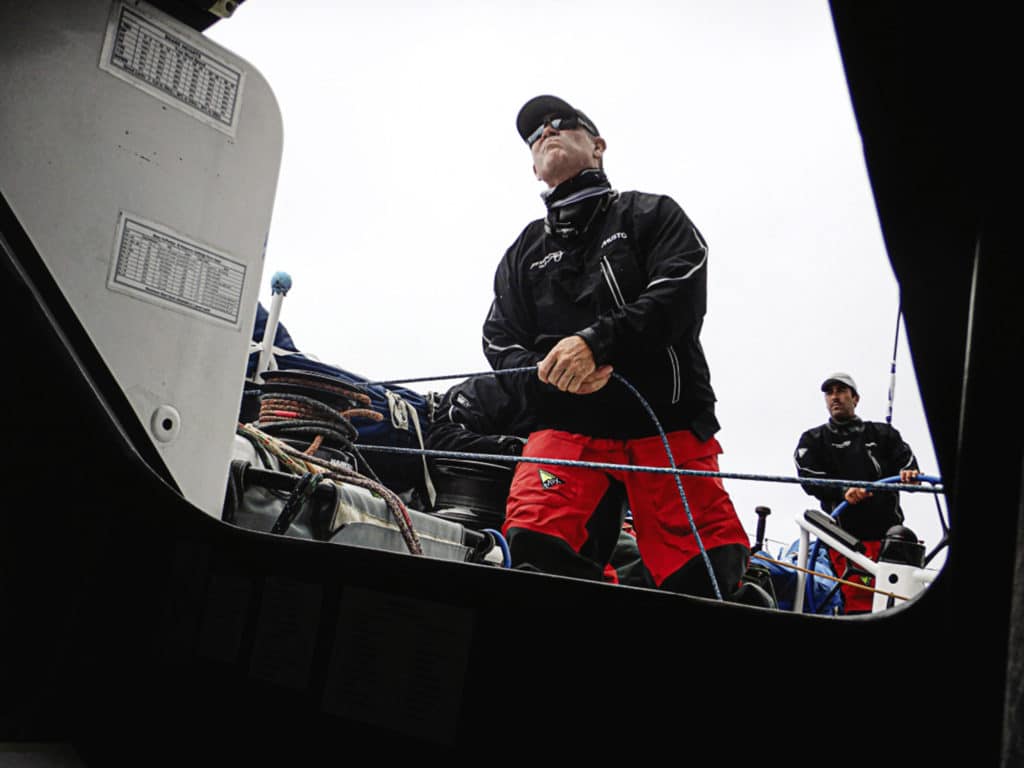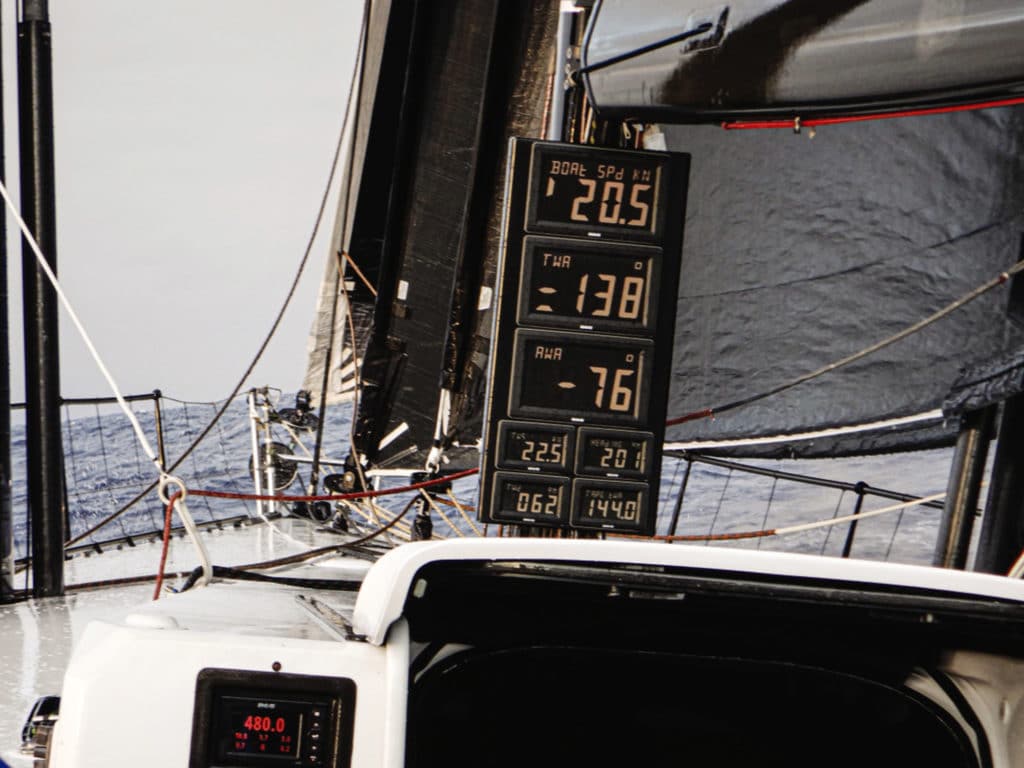
Close your eyes and imagine a 2,200-mile ocean race where you start out going upwind in light air. Not very exciting—yet. But within a few hours, you transition to a few hundred miles of brisk and sometimes rough close reaching across a chilly ocean under gray skies. Not fun—yet. Then, over the course of half a day, you go through the boat’s entire reaching sail arsenal until the wind is aft and you are surfing downwind in 18-knot trade winds for days. Now it’s getting good.
But wait—it gets better.
The wind builds into the mid-20s, and the swells stack up neatly. You’re shredding toward the finish as a full moon reveals dramatic volcanic peaks of an island chain, which is your final destination. You open your eyes to behold the iconic shape of Diamond Head crater on Oahu that marks the end of the race. That’s your Transpacific Yacht Race, the best point-to-point sailing adventure on the planet.
My first Transpac was 30 years ago, and I remember it like it was yesterday. I was just out of college and into an Olympic Soling campaign when I accepted Dave Ullman’s invitation to navigate a West Coast “sled.” This particular Santa Cruz 50 was one of seven Santa Cruz-built and Bill Lee-designed ULDBs entered that year. Thirty miles from the finish, we were side by side with a sistership, surfing huge swells in 25 knots while vying to be first to finish in our unofficial subclass of Santa Cruz 50s.
With a full moon providing just enough illumination to see dolphins playing off each side of our bow, and the Allman Brothers’ “Mountain Jam” cranking through the on-deck speakers, we slid forward wave by wave in 20-knot bursts to a two-minute margin at Diamond Head. Our elapsed time in that windy year was nine days and 15 hours, a respectable run considering the reigning record holder (the 67-foot ULDB Merlin) narrowly missed the course record by a minute with an eight-day, 11-hour passage.
Fast-forward to 2021. I’ve done my fair share of Transpacs, and even navigated a record-setter (Hasso Plattner’s 86-footer Morning Glory at six days and 16 hours), but I still got that tingle of excitement when Robbie Haines and Roy Pat Disney invited me to navigate Disney’s turbocharged Volvo 70, Pyewacket 70 (ex‑Telefonica and Black Jack), in this year’s race. (Pyewacket is the name of a magical cat in a 1950s movie that was a favorite of Disney’s late father.) The Pyewacket 70 team is the preeminent West Coast offshore racing program, and it’s an honor to get the chance to wear the logo of the cat. The entire Pyewacket season in a Transpac year focuses on the July race, and we got off to a great start in March by setting the record in the Newport to Cabo San Lucas Yacht Race, which gave those of us who had not been around the planet lately a taste of what a turbocharged Volvo 70 was like on a VMG run in 20-plus-knot winds. Let me tell you, it’s fast, averaging over 20 knots, and very wet because the bow incessantly throws huge shards of spray over the deck as it catches up to the wave ahead.
After Cabo, a lot of preparation focused on getting the bow up (weight aft) and sealing all the little leaks that don’t seem little when there’s inches of water constantly running over the deck and into the cockpit. As the race date approached, it became clear that the coveted Barn Door Trophy for the first elapsed time was ours for the taking. The 100-footer Rio had withdrawn, so we had the fastest rating of the fleet—by a lot. Our closest rival was the Maxi 72 Lucky (ex-Bella Mente).
To get the fleet to finish in close proximity, the slowest boats started three days before the race’s big hardware, and a middle-speed fleet started the day before us. Unfortunately for them, an eddy spinning off Point Conception made for a painfully slow exit from the coast. The situation had normalized by the time we started, so we had an easier time getting to the synoptic northwesterly, which took us only a few hours to reach. As our meteorologist, Chris Bedford, noted on the morning of the start, race conditions looked to be “typical.” Transpac organizers handicap the fleet based on an average matrix of wind angles and wind speeds, and the models were looking just like the matrix. However, as Disney’s father used to say, “The devil is in the details.”
As we close-reached away from the City of Angels with an easygoing 15-knot breeze, the challenge was to shift gears in frequent lulls and puffs. This sort of unstable and shifty situation continued for almost two days, until we finally made it through the ridge and got our VMG gear ready to deploy. No one ever remembers the first, cold-reaching part of the race. Surfing downwind in the trades is what makes the price of admission a real steal.
Pyewacket 70 had its grinding pedestals replaced in favor of a super-powerful hydraulic system a few years ago when it raced Down Under as Black Jack. Push-button sailing makes a Volvo 70 a much different ride, with halyards and sheets adjustable by fingertip. It’s easy on the body, but it requires the engine to run during all major adjustments. The engine, therefore, runs nearly 24/7 when the wind is unstable, as it was during the reach, revving with every button push.
Inside the carbon-fiber drum of a hull, it’s incredibly loud, requiring ear protection to sleep or navigate. The mainsheet winch can operate under battery power, and when you are running VMG on Pyewacket 70, that’s the only sail that needs constant trimming. Pyewacket 70 sails downwind in 18 to 20 knots with a triple-head rig. Our big A3 gets the first look at the apparent wind. It’s set off the tip of the bowsprit, but it’s not like any other downwind sail used by the Transpac fleet. Pyewacket 70 is so fast that the apparent wind is always well ahead of the beam, so our downwind inventory looks more like a fast multihull’s quiver. The A3 looks and trims like a jib, and inside of it, the J4 (our heavy-air upwind jib) and a small staysail add area and deflect the flow around the mainsail.
With this setup, steering the boat downwind is really a game of apparent-wind management. All those big takeoff ramps provided by ocean swells look tempting to turn down into and go for a big surf, but this boat wants to keep the wind flowing across the sails. As a result, all three front sails are normally cleated, except when adjusting to a windspeed (apparent wind) change.

Unlike every other boat I’ve sailed to Hawaii, where a trimmer and grinder play the curl of the spinnaker, on Pyewacket 70, the helmsman just keeps it ripping, and the main trimmer provides the balance and the pumps when appropriate.
The main trimmer has a wireless remote control close at hand to do all the grinding. So, for a boat with a six-person on watch, only two sailors are actively sailing the boat downwind, and the rest stand around behind the wheel, keeping their weight aft (since the weather rail is stacked high with all sails, as permitted by the race rules). From the back of the boat, you have to stand on your toes to see the horizon over the stack. Sitting down on the cockpit floor is OK in some conditions, but if it’s windy enough, the deck is so awash, it’s like sitting in a bubbling stream—even on the high side.
All this standing around comes to an end when it’s time to jibe. Everyone but the helmsman and main trimmer turns into a glorified moving-van crew, lugging the extremely heavy sail package (even our medium air jib weighs more than 200 pounds) from the windward side to the leeward (soon-to-be windward) side. One by one, the sails are moved with the help of gravity. By the end of the race, we had the system refined and could be ready to jibe in 12 minutes.
Steering the boat downwind is really a game of apparent-wind management. This boat wants to keep the wind flowing across the sails.
A couple of days out from the finish, it looked as if the right corner (looking downwind) was the way to go, which gave us an opportunity to go for Transpac’s coveted 24-hour record, which had been set by the 100-foot supermaxi Comanche, navigated by longtime Pyewacket navigator Stan Honey (my college roommate).
We discussed the pros and cons of committing to the record attempt within a race. It looked as if it would not affect our corrected-time position much, if at all, but it would mean that we would have to close our eyes when sailing through squalls and big lifts. Luckily, the wind stayed on forecast for the most part, and we had an epic port jibe for about 27 hours. It was long enough to shred Comanche’s 482-mile record by 23 miles. In a 24-hour period, we averaged 21 knots in 20- to 22-knot winds. All 13 of the crew made sure they had a bit of skin in the game by driving for at least one fun session.
We pushed the record run as far as we could until we were in danger of not laying the east end of Molokai when we jibed, and then went back to work shuffling sails. Once on starboard, we decided it was “two and in” to Diamond Head, so we watched Pyewacket regular Capt. Gary Weisman revive a tradition that the Pyewacket 70 crew celebrates on Disney’s much-tamer 68-foot sled, also named Pyewacket. A couple of bottles of nice red wine appeared on deck behind the helm, and soon we were all enjoying a toast together. It didn’t matter that the wine had a hint of sea-salt spray in the nose. It did the trick.
Of course, none of us will remember the first part—just our final sprint with the full moon illuminating Oahu as we ripped into the finish in the biggest puffs of the race, a bit overstood on the layline (blame the wine, not the navigator). We saw 29 knots for a couple of seconds in Molokai Channel, which was also our top speed for the race. The workhorse A3 in its triple-head configuration with one reef in the mainsail saw us into the finish line with an elapsed time of five days, 16 hours and 53 minutes.
Because we finished at night, Disney was kind enough to accede to photographer Sharon Green’s request to take the boat out and do it again in daylight. So, two days later, after a bit of a rest, the Pyewacket team headed upwind into the Molokai Channel with a double reef and a number-four jib to set up for another victory lap past Diamond Head. This time we had a helicopter ready to get the money shot. When we finally turned and burned, we all remembered why we love this race so much. Downwind is the delight.









